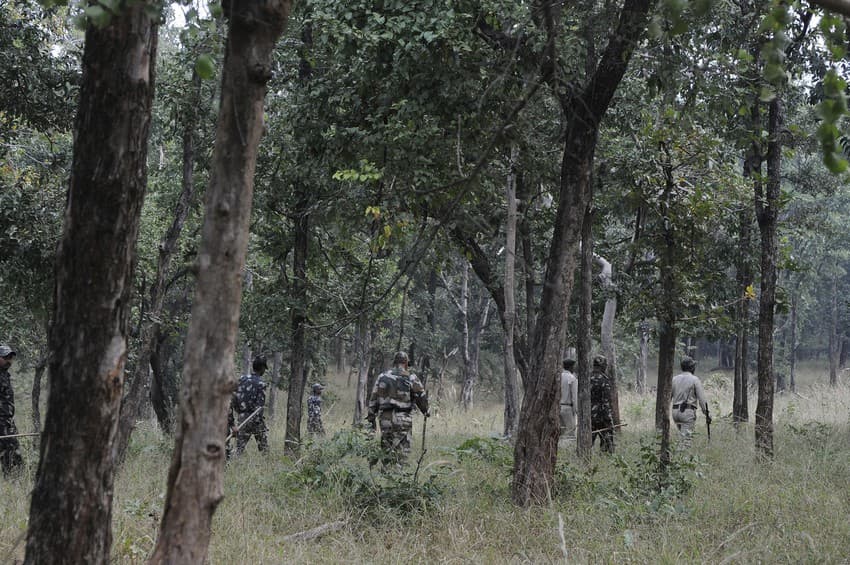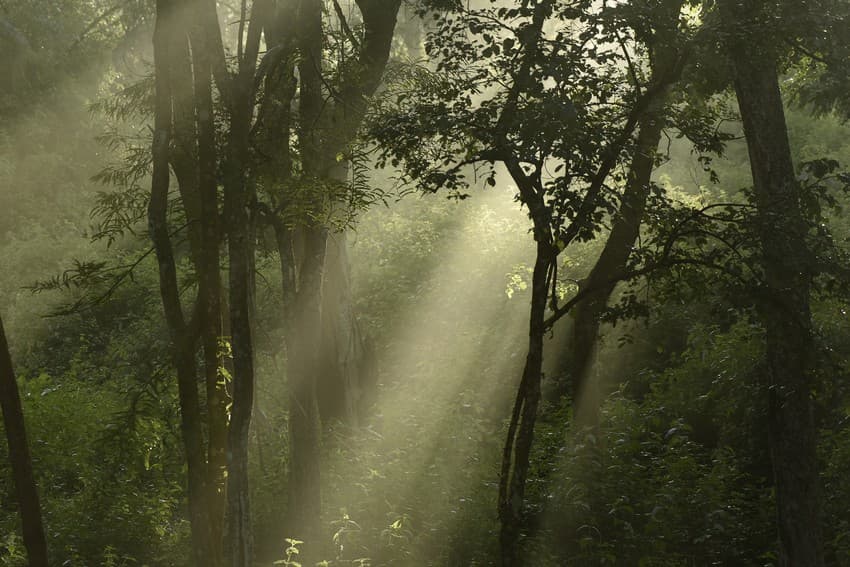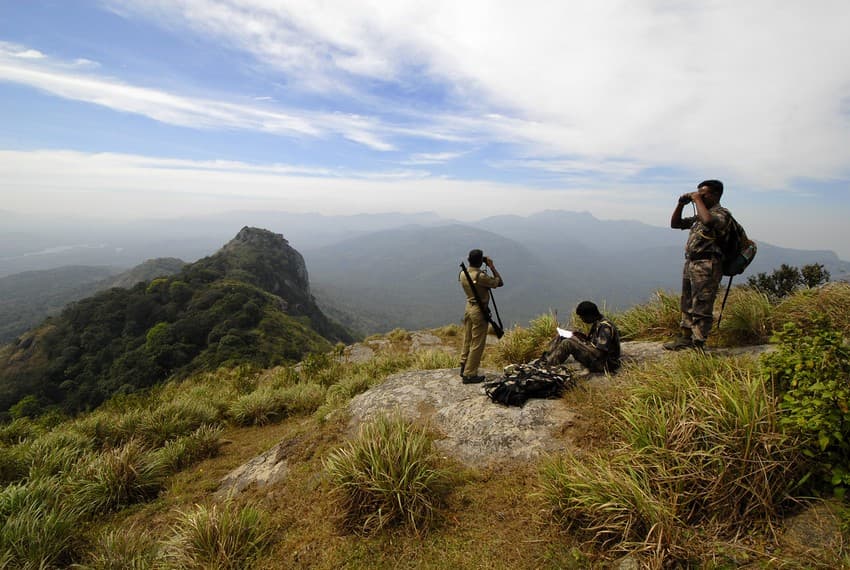The pandemic has forced much of humanity to retreat in the hopes of containing the virus. On March 25, 2020, India announced the world’s largest lockdown in a massive effort to combat the spread of the infection. While most citizens have confined themselves to their homes and various working sectors have been forced to scale down their work and workforce, India’s forest force continues to perform its already complex, challenging job of protecting wild habitats and wildlife, and managing the Protected Areas. This is one sector that cannot afford to come to a standstill, or be scaled down. Our last few remaining vestiges of natural capital won’t stand for it.
The pandemic has definitely affected India’s forest protection force. Mandatory safety measures have been put in place for the forest staff, which has increased its vigil across Protected Areas and is on high alert. Photo: Anish Andheria
The Protected Areas comprising tiger reserves, wildlife sanctuaries and national parks have to be strategically patrolled and monitored by the field staff day and night to keep illegal activities such as hunting, encroachment, trespassing, etc. at bay; fire lines have to be created and maintained before the dry season sets in; water and soil conservation measures need to be implemented regularly and meticulously; and these are just some of the heavy duty work the forest management is tasked with.
Wildlife crimes are a perpetual scourge. The Forest Department being the foremost wildlife law enforcement agency, has to be alert, report to investigate crime cases, make arrests, conduct seizures of illegal contraband, and basically, uphold the country’s wildlife laws.
Additionally, human-wildlife conflict is a burgeoning threat that keeps the Forest Department on its toes, and it simply cannot be allowed to intensify or escalate. Prasenjeet Navgire, Law Enforcement Monitoring expert with Wildlife Conservation Trust (WCT), expresses concern. “With the return of several people from urban areas to their home towns and villages in the rural parts and scarcity of essentials owing to the lockdown, will likely intensify the problem of poverty for the villagers. They might resort to hunting wildlife for bushmeat for local consumption. Untested and illegal use of wildlife products for traditional medicines may also increase. With wildlife straying out of the forests into relatively human-free streets and spaces, cases of opportunistic hunting could go up. More and more people may start to venture into the forests for wood and other forest produce putting pressure on forests and wildlife. And in turn, this could lead to a spike in human-wildlife conflict. The Forest Department is aware of this and is on guard.”
So how are the foresters in India executing their duties in the time of COVID-19?
“The foot patrols are being conducted on a regular basis like before. We are also patrolling the peripheral areas of the tiger reserve more intensively and extensively to keep a strong vigil and monitor wildlife to avoid conflict situations. While patrolling, we take utmost care to keep reasonable distance from each other as part of our efforts to practice social distancing,” a staff member of the Special Tiger Protection Force (STPF) of Nawegaon-Nagzira Tiger Reserve, tells us.

Foot patrolling is central to India’s forest protection efforts. Forest guards negotiate difficult terrains and situations in the process. Photo: Anish Andheria
Keeping in mind the urgent need for social distancing and other COVID containment practices, the Forest Department is taking various precautionary measures. Masks and soaps have been distributed among the forest guards in the tiger reserves. The field staff has been instructed to wear masks, and keep a reasonable distance from each other when on duty. Several advisories and guidelines have been issued by central wildlife bodies such as the Ministry of Environment, Forests and Climate Change (MoEFCC), National Tiger Conservation Authority (NTCA) and Central Zoo Authority (CZA) for the welfare of the forest staff and wildlife, and to prevent transmission of the disease.
To reduce interaction, the management staff has been keeping tabs on the field staff using virtual communication applications such as WhatsApp through regular messaging and selfie updates. The tiger reserves continue to implement the use of government-mandated software known as Monitoring System for Tigers Intensive Protection and Ecological Status (MSTrIPES), created to assist in wildlife protection, monitoring, and management of forests and wildlife. Under MSTrIPES protocols, forest guards are expected to patrol their beats and record their tracks, and further, note down observations on data sheets.
But, there is a valid fear that has set in among the field staff. Concerns about their own health and their family’s well-being understandably looms large. Being stationed far away from their families for long periods of time, in remote locations, especially under these tense circumstances with barely sufficient income and benefits, all add to their worries.
In Sakoli, a town near the Nawegaon-Nagzira Tiger Reserve, a batch of returning field staff was immediately tested and compulsorily quarantined for 14 days. Such measures are commendable on the part of the government and must be implemented in all states so that they succeed in preventing transmission of the virus among the forest staff and even from the staff on to wild animals.
The recent news of a four-year-old Malayan tiger in Bronx Zoo in the United States of America, having tested positive for COVID-19 in a rare event of human-to-animal virus transmission, has set the alarm bells ringing out of concern for the wild tigers and other wildlife. In India, the MoEFCC has circulated an advisory regarding “containment and management of COVID-19 in National Parks/Sanctuaries/Tiger Reserves” to the Chief Wildlife Wardens of all states and Union Territories. The advisory has ordered for “immediate preventive measures to stop the transmission and spread of the virus”, “reduce in [sic] human-wildlife interface”, “restrict people’s movements to National Parks/Sanctuaries/Tiger Reserves”, “Constitute a Task force/Rapid Action Force… to manage the situation as quickly as possible’, “Set up essential services for emergency treatment of animals and their safe release back to their natural habitats, when possible”, and such other important mandates.
These are truly testing times for the frontline forest staff who are performing their duty commendably by keeping a stronger vigil, defusing potential man-animal conflict situations, working overtime, all the while ensuring each other’s safety. Senior forest officers are now joining their field staff in patrolling and monitoring duties in an effort to ramp up the forest protection efforts.
Reports of wildlife crime and conflicts from different parts of the country keep rolling in even during a nation-wide lockdown. While, on one hand, the Uttarakhand Forest Department was making a seizure of pangolin and porcupine meat on March 28, 2020, the Karnataka Forest Department was busy arresting a group of men who had entered the Bandipur Tiger Reserve carrying guns, and on the same day, a Range Forest Officer along with the field staff seized a trolley full of illegally mined sand on the outskirts of the Nawegaon-Nagzira Tiger Reserve, Maharashtra. In a separate incident, another person was arrested for encroachment and lighting fire in Bandipur recently. On April 13, 2020, in Rajasthan, an alert forest guard, Behera Ram Bishnoi, in Rajsamand district, averted an incident of human-leopard conflict by wisely handling the delicate situation which also led to a heartwarming reunion of lost leopard cubs with their mother.

Protecting wildlife and ecosystems is crucial to India’s food, water, air and economic security. But, our dwindling forests and other wild habitats are increasingly threatened by human activities. Photo: Anish Andheria
“Our work continues unabated. The field and management staff are working tirelessly to protect the tiger reserve even in these times. The senior officers, including me, join the field staff on foot patrols, visit anti-poaching camps in the remotest reaches of the tiger reserve to ensure the health and morale of the staff is maintained. The staff has been busy conducting a wildlife population estimation exercise in the tiger reserve and have deployed several camera traps in the field. Such activities cannot be postponed and have to be performed methodically in a specific timeframe. Challenges are plenty. But, I will ensure the safety of my staff and efficacy of forest protection,” said Shri. Manikandan Ramanujam, IFS, Field Director, Nawegaon-Nagzira Tiger Reserve.
The Indian forest force is a force to reckon with, and even in these challenging times, they continue to put the welfare of wildlife first. Their service is helping to protect the very ecosystems in whose sound health and well-being lies our answer to prevent such pandemics from occurring in the future.
——————————————————————————————————————————————————————
About the Author: Purva Variyar is a conservation and science writer at the Wildlife Conservation Trust, India.
——————————————————————————————————————————————————————
Disclaimer: The author is associated with Wildlife Conservation Trust. The views and opinions expressed in the article are her own and do not necessarily reflect the views and opinions of Wildlife Conservation Trust.
Related Links
- Reinforcing Forest Protection
- Human Wildlife Interface Management
- Our Approach
- Connectivity Conservation
- Tiger Matters – A Documentary on our 360 Degree Approach to Conservation

